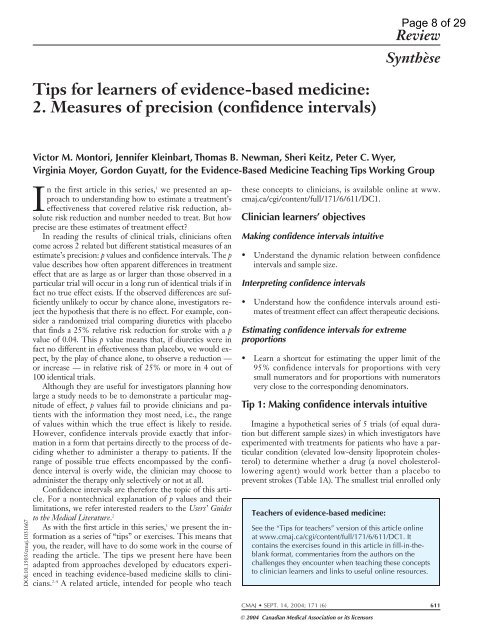Tips for Learners of Evidence-Based Medicine
Tips for Learners of Evidence-Based Medicine
Tips for Learners of Evidence-Based Medicine
You also want an ePaper? Increase the reach of your titles
YUMPU automatically turns print PDFs into web optimized ePapers that Google loves.
DOI:10.1503/cmaj.1031667<br />
<strong>Tips</strong> <strong>for</strong> learners <strong>of</strong> evidence-based medicine:<br />
2. Measures <strong>of</strong> precision (confidence intervals)<br />
In the first article in this series, 1 we presented an approach<br />
to understanding how to estimate a treatment’s<br />
effectiveness that covered relative risk reduction, absolute<br />
risk reduction and number needed to treat. But how<br />
precise are these estimates <strong>of</strong> treatment effect?<br />
In reading the results <strong>of</strong> clinical trials, clinicians <strong>of</strong>ten<br />
come across 2 related but different statistical measures <strong>of</strong> an<br />
estimate’s precision: p values and confidence intervals. The p<br />
value describes how <strong>of</strong>ten apparent differences in treatment<br />
effect that are as large as or larger than those observed in a<br />
particular trial will occur in a long run <strong>of</strong> identical trials if in<br />
fact no true effect exists. If the observed differences are sufficiently<br />
unlikely to occur by chance alone, investigators reject<br />
the hypothesis that there is no effect. For example, consider<br />
a randomized trial comparing diuretics with placebo<br />
that finds a 25% relative risk reduction <strong>for</strong> stroke with a p<br />
value <strong>of</strong> 0.04. This p value means that, if diuretics were in<br />
fact no different in effectiveness than placebo, we would expect,<br />
by the play <strong>of</strong> chance alone, to observe a reduction —<br />
or increase — in relative risk <strong>of</strong> 25% or more in 4 out <strong>of</strong><br />
100 identical trials.<br />
Although they are useful <strong>for</strong> investigators planning how<br />
large a study needs to be to demonstrate a particular magnitude<br />
<strong>of</strong> effect, p values fail to provide clinicians and patients<br />
with the in<strong>for</strong>mation they most need, i.e., the range<br />
<strong>of</strong> values within which the true effect is likely to reside.<br />
However, confidence intervals provide exactly that in<strong>for</strong>mation<br />
in a <strong>for</strong>m that pertains directly to the process <strong>of</strong> deciding<br />
whether to administer a therapy to patients. If the<br />
range <strong>of</strong> possible true effects encompassed by the confidence<br />
interval is overly wide, the clinician may choose to<br />
administer the therapy only selectively or not at all.<br />
Confidence intervals are there<strong>for</strong>e the topic <strong>of</strong> this article.<br />
For a nontechnical explanation <strong>of</strong> p values and their<br />
limitations, we refer interested readers to the Users’ Guides<br />
to the Medical Literature. 2<br />
As with the first article in this series, 1 we present the in<strong>for</strong>mation<br />
as a series <strong>of</strong> “tips” or exercises. This means that<br />
you, the reader, will have to do some work in the course <strong>of</strong><br />
reading the article. The tips we present here have been<br />
adapted from approaches developed by educators experienced<br />
in teaching evidence-based medicine skills to clinicians.<br />
2-4 A related article, intended <strong>for</strong> people who teach<br />
Review<br />
Synthèse<br />
Victor M. Montori, Jennifer Kleinbart, Thomas B. Newman, Sheri Keitz, Peter C. Wyer,<br />
Virginia Moyer, Gordon Guyatt, <strong>for</strong> the <strong>Evidence</strong>-<strong>Based</strong> <strong>Medicine</strong> Teaching <strong>Tips</strong> Working Group<br />
these concepts to clinicians, is available online at www.<br />
cmaj.ca/cgi/content/full/171/6/611/DC1.<br />
Clinician learners’ objectives<br />
Making confidence intervals intuitive<br />
• Understand the dynamic relation between confidence<br />
intervals and sample size.<br />
Interpreting confidence intervals<br />
• Understand how the confidence intervals around estimates<br />
<strong>of</strong> treatment effect can affect therapeutic decisions.<br />
Estimating confidence intervals <strong>for</strong> extreme<br />
proportions<br />
• Learn a shortcut <strong>for</strong> estimating the upper limit <strong>of</strong> the<br />
95% confidence intervals <strong>for</strong> proportions with very<br />
small numerators and <strong>for</strong> proportions with numerators<br />
very close to the corresponding denominators.<br />
Tip 1: Making confidence intervals intuitive<br />
Imagine a hypothetical series <strong>of</strong> 5 trials (<strong>of</strong> equal duration<br />
but different sample sizes) in which investigators have<br />
experimented with treatments <strong>for</strong> patients who have a particular<br />
condition (elevated low-density lipoprotein cholesterol)<br />
to determine whether a drug (a novel cholesterollowering<br />
agent) would work better than a placebo to<br />
prevent strokes (Table 1A). The smallest trial enrolled only<br />
Teachers <strong>of</strong> evidence-based medicine:<br />
See the “<strong>Tips</strong> <strong>for</strong> teachers” version <strong>of</strong> this article online<br />
at www.cmaj.ca/cgi/content/full/171/6/611/DC1. It<br />
contains the exercises found in this article in fill-in-theblank<br />
<strong>for</strong>mat, commentaries from the authors on the<br />
challenges they encounter when teaching these concepts<br />
to clinician learners and links to useful online resources.<br />
CMAJ • SEPT. 14, 2004; 171 (6) 611<br />
© 2004 Canadian Medical Association or its licensors<br />
Page 8 <strong>of</strong> 29
















